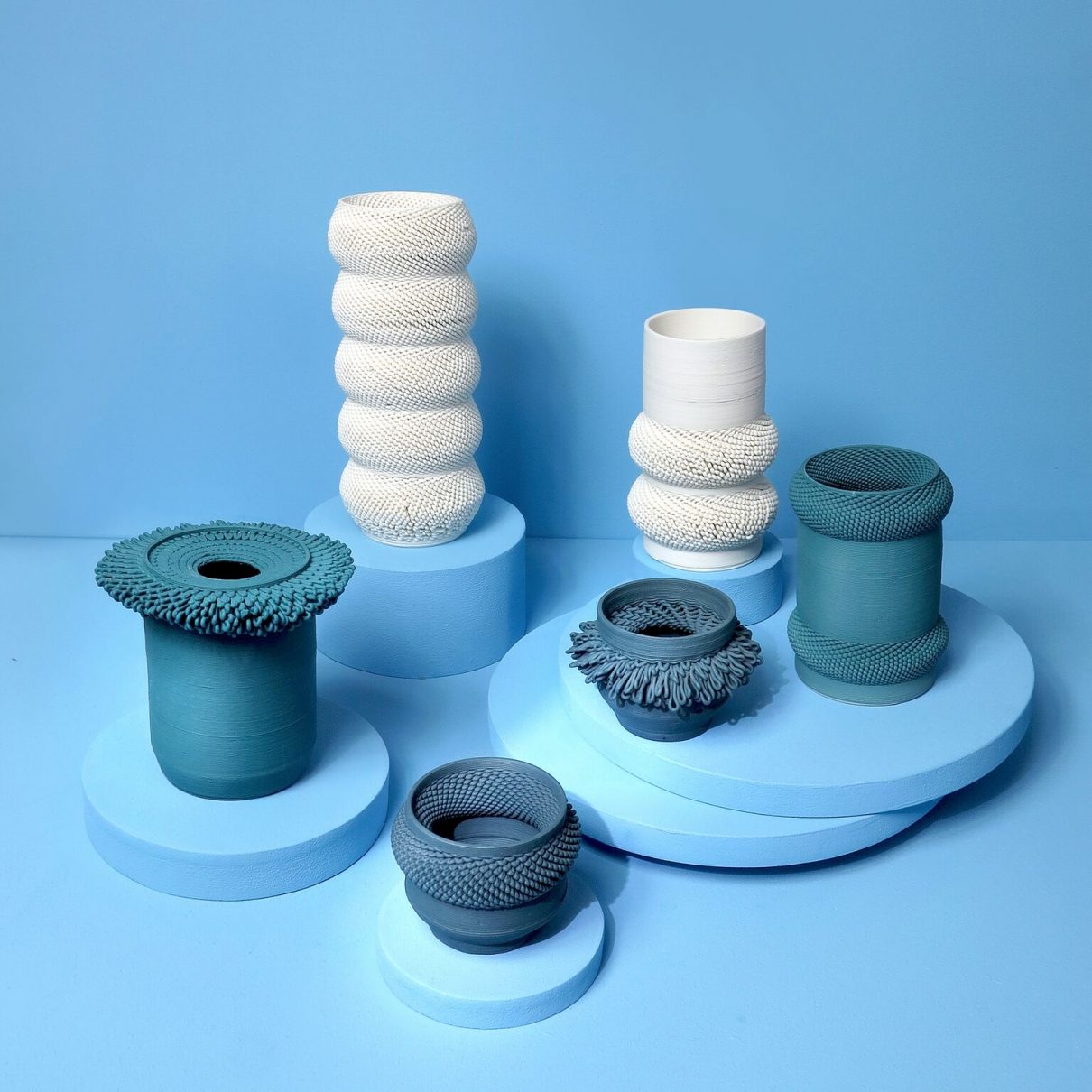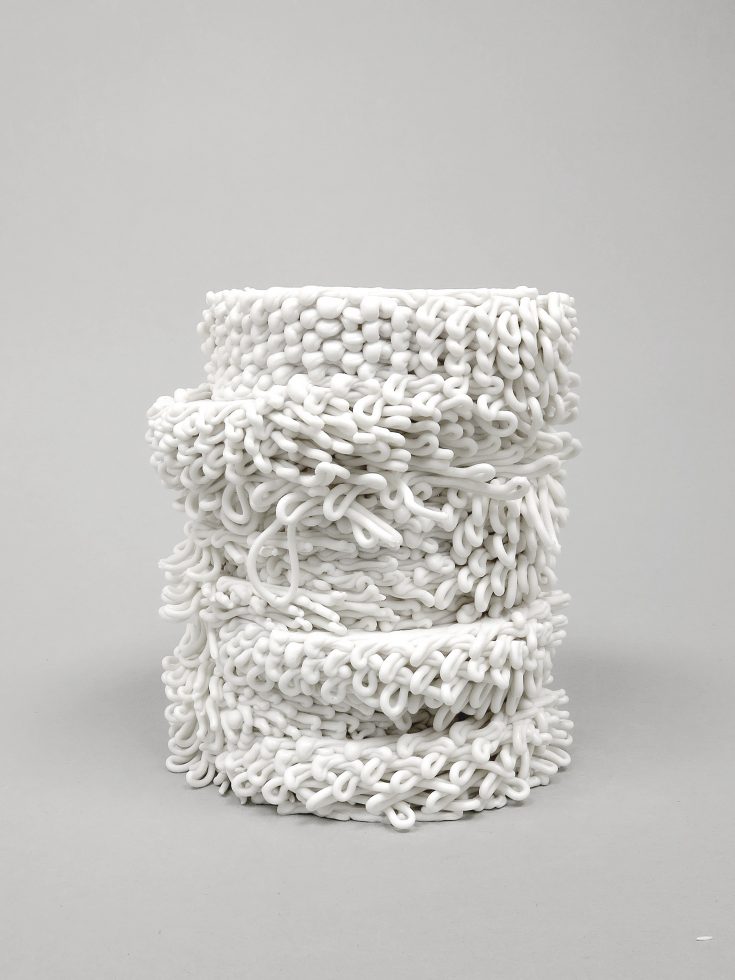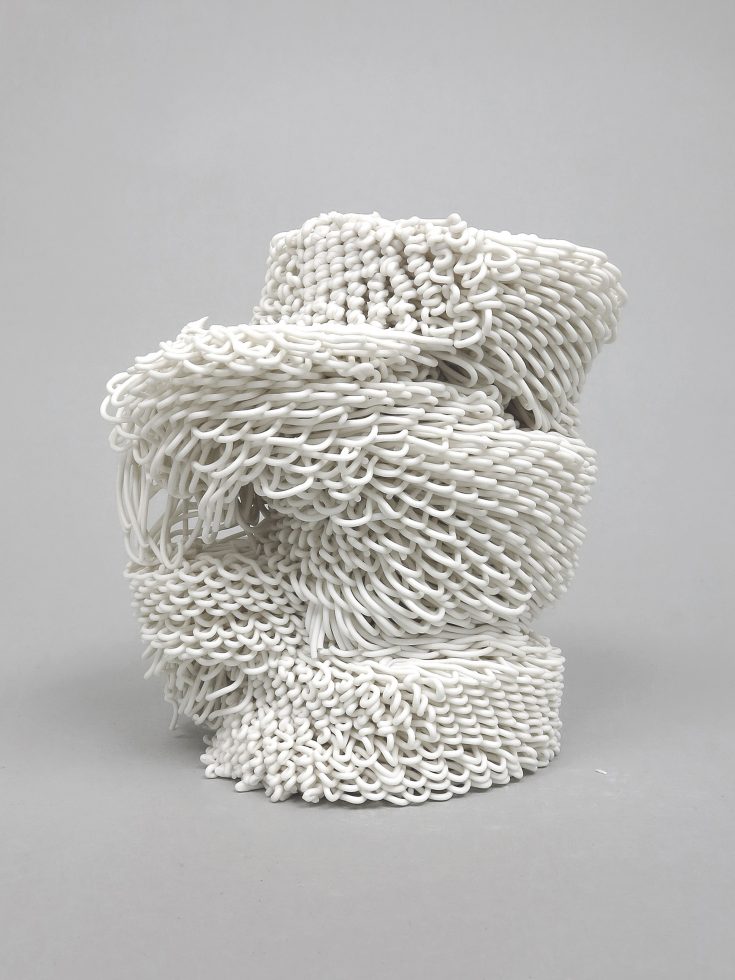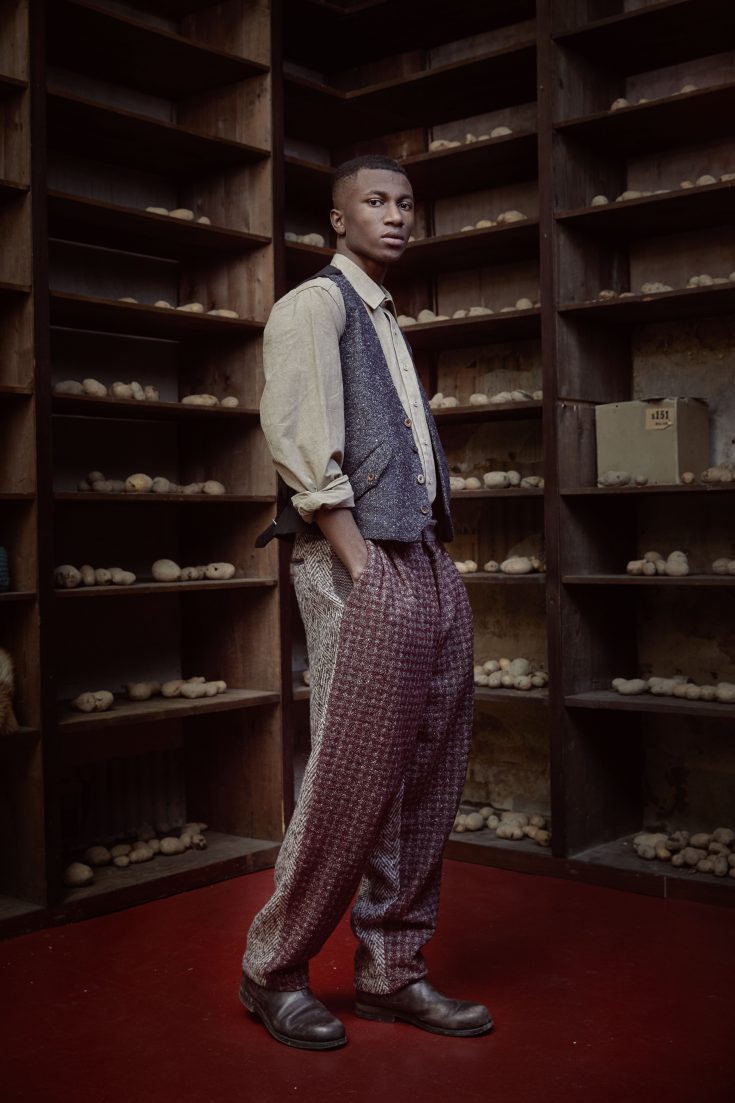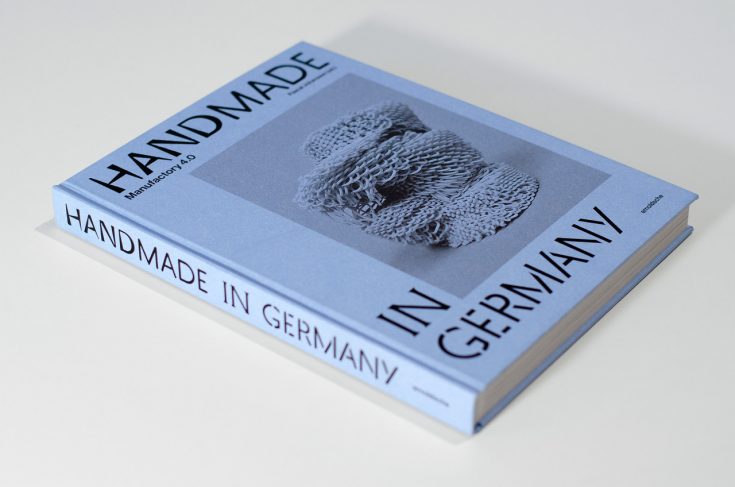Additive Addicted makes it happen
The designer duo Additive Addicted is already showing how the future may look today. Inside the work of design collective Additive Addicted technologies of digital production meet a material that is thousands of years old: porcelain. In order to highlight its special properties and qualities, the collective develops parametric and generative strategies for programming and controlling the movements of a ceramic 3D printer. The result is objects with filigree, highly complex structures reminiscent of textiles. The symbiosis of technology and material results in an unseen repertoire of forms that would not be possible with conventional ceramic techniques.
The collective was founded in Berlin in 2017 by product designer and art historian Babette Wiezorek and interaction designer Dawei Yang. Additive Addicted researches and works in the field of tension between material expertise and development, generative coding and technological process design for additive, computer-aided manufacturing processes with fluid materials with a special focus on ceramic materials. On one hand, Additive Addicted produces and distributes configurable ceramic objects, on the other it’s workshops convey the special qualities of the process and make connection technologies of coding and generative design tangible. Additive Addicted sees itself as a laboratory that researches, produces and communicates, thus sounding out, questioning and advancing the potential of 3D printing and the emerging digital industry.
Complexity for free
What do these experiments mean for other scenarios of application? Measured by the weight and volume of conventionally manufactured components, additive manufacturing methods are much more expensive in most cases. One of the most important advantages of 3D printing over conventional manufacturing methods is its financial and technical independence from the complexity of the components. Economic cornerstones are material, volume, installation space and printing time — complexity does not matter. To manufacture a component, only one primary forming process is used instead of several different forming processes (rolling, milling, bending, drilling, etc.). The invention of plastic injection moulding was similarly revolutionary. However, this is still subject to severe restrictions regarding the direction of demolding, material thicknesses etc. and requires the manufacture of very expensive tools.
In additive processes, much more complex structures and even internal moving functional parts can be produced. Screws, nuts, bolts, clips are no longer necessary, and so is their assembly. By means of an intelligent design, it is possible to save time and money by integrating several components into one component. This fuel injection nozzle for aircraft engines, where 20 components have been combined into a single component, can serve as an example of this.
Lightweight construction
In aviation, small savings are followed by big results. Lufthansa, for example, determined that one kilogram of weight savings in one of its MD-11s would result in a saving of 10 tons of kerosene per year. What leads to eco-efficiency and cost-effectiveness in civil aviation can lead to performance gains and longer flight times in the construction of flying drones and already have a major impact in the gram range. Researchers are already using 3D printing to produce materials with a better force-to-weight ratio than the hardest known technical materials. The combination of pressure-stable structures and tensile ropes, as well as parametric design, can represent a promising field of research.
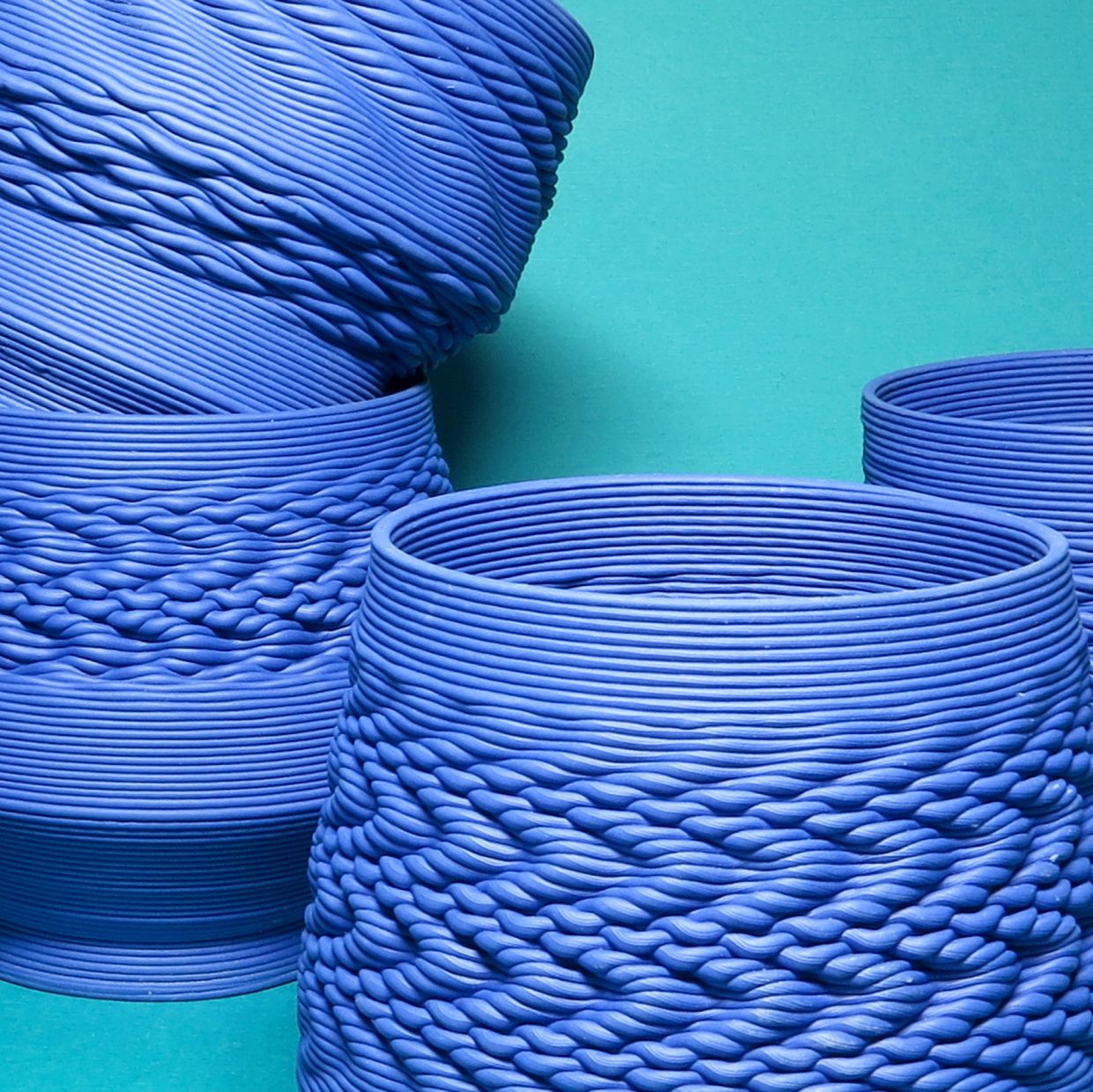
Miniaturization
Miniaturization is playing an increasingly important role in many fields of application. In electronics, hardware is becoming increasingly smaller, in medicine more and more operations can be realized with minimal invasion, even in space travel nanocube satellites with an edge length of 10 centimeters are capable of realizing tasks such as former satellites weighing tons and soon promise, for example, global earth observation and communication in swarms. The already mentioned advantages in lightweight construction and the generation of complex microstructures will be reduced to undreamt-of scales by new additive manufacturing technologies such as multiphoton lithography. Two lasers intersect in a space point accurate to the nanometer and cure a polymer by wave superposition. In this process, components can be realized in the micrometer range that can be placed on the tip of a human hair. Even if these technologies are not yet available on the market, they can soon be expected due to the predominantly rapid development. Industrial and product designers, as well as manufacturers, will find completely new possibilities here, which can already be investigated experimentally on a larger scale today.
Speed
The production of the individual parts of products in additive processes is often even more time-consuming than in conventional processes. However, the development and production of the product itself can be realised in a time which cannot be achieved with conventional means and methods. Instead of years of market research, development and production in hundreds of thousands of editions, additive processes can be used very early and continuously. A quick reaction to sudden events and market developments can give companies enormous competitive advantages and a boost to its image. However, since products cannot be translated one to one into additive manufacturing processes, it is important to focus on production-oriented design for rapid manufacturing in teaching and research. Furthermore, the design methodology differs considerably. Fast iterative steps at the provisional end product, an agile development of hardware is still unexplored today and also a promising design theoretical research approach, whose employment would have a positive effect on universities and the surrounding economy.
Freedom of design
By means of additive manufacturing, objects can be realized, which cannot be produced with today’s production methods or only with great effort. The scope of design and the possibilities of production are enormously expanded. The possibilities of this technology are very closely linked to those of CAD design, which present their users with new challenges. Research in and through design should therefore deal with both sides.
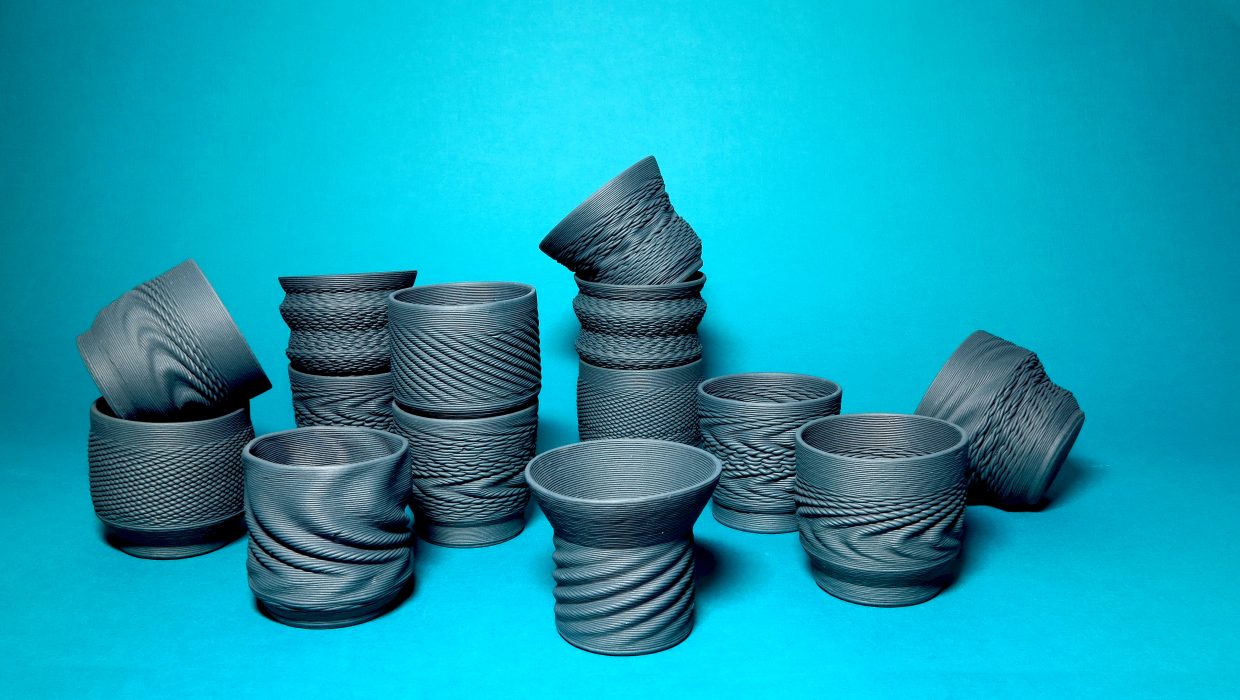
Economic efficiency
Additive manufacturing processes can bring enormous economic advantages, which are not necessarily achieved in unit costs, but rather systemically. Through additive production, more can be produced in the factory and without assembly, thus eliminating supply margins for subcomponents and assembly. Reducing the size of the machine park and saving personnel costs by using a uniform means of production reduces fixed costs, investment costs and the dependency and risk of downtime on skilled personnel. In addition, more favorable or better customer support can be provided if the spare parts are not produced from stored production surpluses but in on-demand production. During development and production planning, production costing is simplified, as no quotations have to be obtained and waited for for subcomponents produced in-house, but only machine time, installation space and material can be calculated. This can be done independently of the sales figures to be forecast.
Deglobalization
On a larger, more economic scale, the introduction of additive manufacturing will also counteract the globalisation of the economy. The economy as a whole will thus be able to generate a larger proportion of its value added in its own country and international dependency will decrease.
However, this also has a noticeable effect on individual companies when they switch to additive manufacturing. Greater self-sufficiency, no communication problems with foreign partners, obsolete foreign production branches and business flights to distant manufacturers save money and reduce risk.
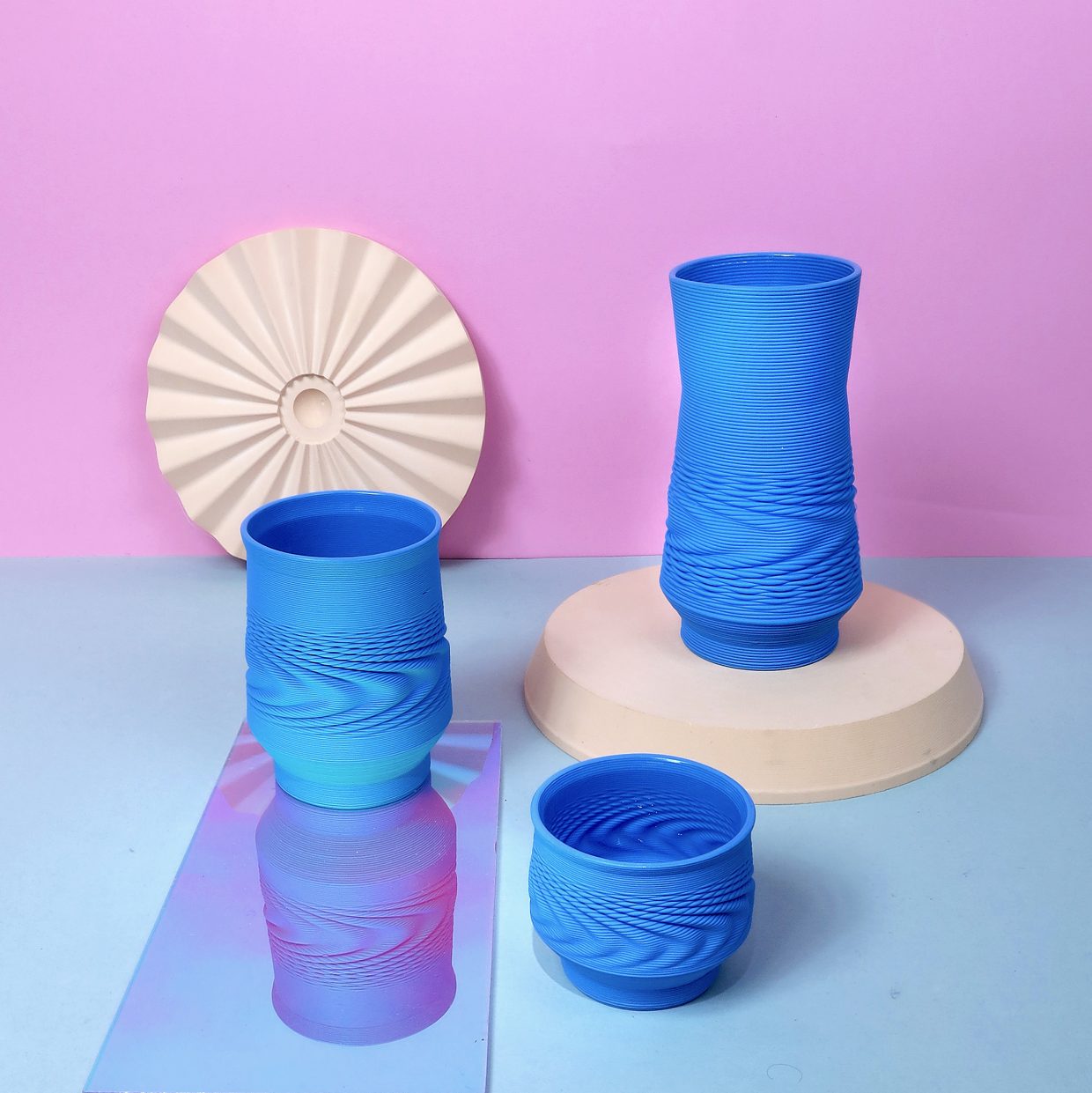
Environment
Various aspects of additive manufacturing have a positive effect on the environment and in some cases also have positive economic effects, and, if not only CO2, also energy is saved as a result. For example, lean and on-demand production reduce warehousing, there is no overproduction and because production takes place close to the point of consumption, transport distances are shortened. The positive effects of lightweight construction applications already mentioned have a positive effect above all in transport, with the greatest impact on air traffic.
Since the amount of components and material wrinkles is reduced in line with production requirements, it is much easier to identify and recycle materials. In addition, there are already many easily recyclable, bio-based and some degradable materials on the market. In contrast to non-European raw materials, those available in Europe are better controlled for pollutants such as toxic plasticizers and flame retardants. Closed material cycles are more likely to be realised with business models based on additive manufacturing.
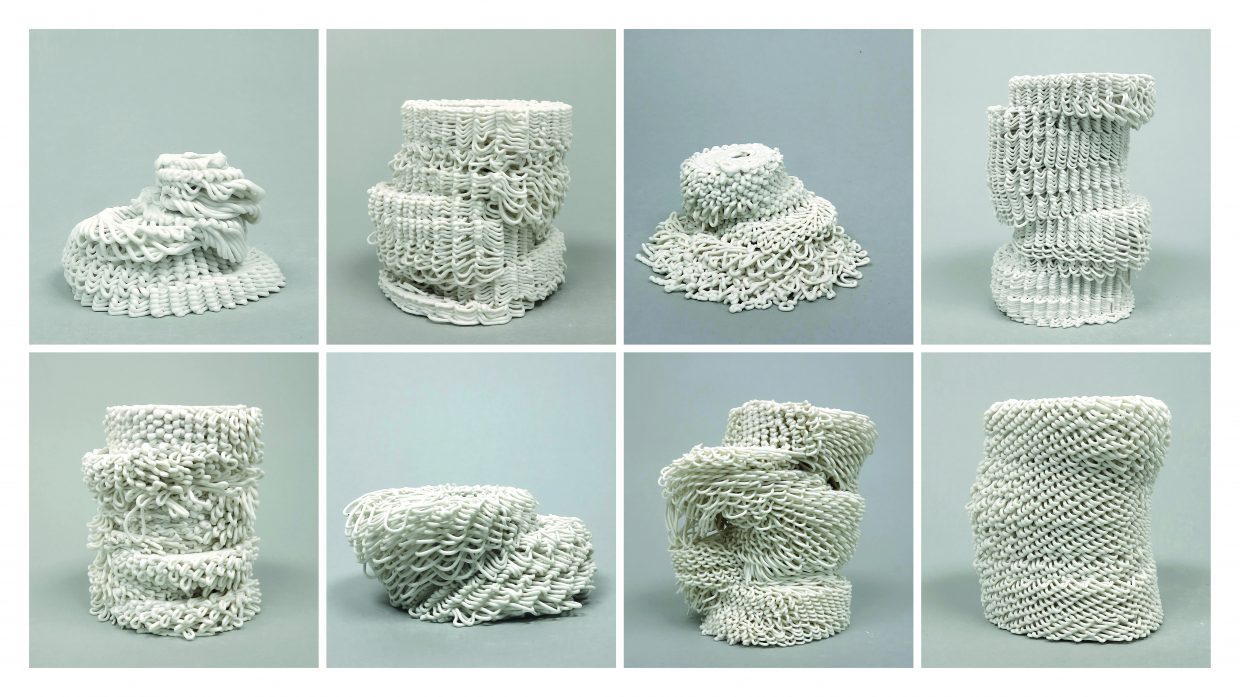
Customisation
One of the most important positive effects of additive technologies is their independence from quantities. For the production of parts, it is irrelevant whether each part is identical or different. This enables not only the already mentioned quantity-independent production, but also an individual adaptation of each individual product for the respective customer. Whether on the basis of the individual ergonomic needs, the concretely detailed body shape in orthopaedics and medical technology or simply on the basis of the customer’s taste, products can be individualised within certain limits without additional production costs. The field of parametric design is particularly relevant because the adaptation of 3D models can be automated.
Independence and flexibility
The aforementioned advantages of independence from suppliers, semi-finished products, spare parts and the flexibility gained by saving time, eliminating warehousing, transport, retooling and adjusting machines become even more relevant if they are not only considered from an economic point of view, but if they make something possible in the first place.
In areas that are difficult to reach, such as under the influence of natural disasters, in war zones, in developing countries, in sparsely populated or unpopulated areas, on islands and in maritime and space travel, we cannot count on an infrastructure and supply chain that is familiar to us. Spare parts can often not be kept as close to hand as they are needed. Defect individual parts cause entire machines and systems to fail that could be urgently needed. The spreading of e.g. sinterable plastic and metal powder, filament, which can be made to anything that is needed at the moment, is much easier to realize. For all these scenarios products which are manufactured in additive processes and which are supplied by the manufacturer with a spare parts database would have an unbeatable sales argument.
Materials
The term “additive manufacturing process” or “3D printing” encompasses many different technologies, each of which can be operated with many different materials. Each has its advantages or disadvantages, special areas of application and also potential in combination with further processing steps. Since there is so much movement in this field at the moment, research into application and further processing possibilities for these new materials is particularly promising. In the following some technologies are considered and described in which way and with which prospect research can be carried out.
Fused Filament Fabrication
Fused Filament Fabrication (FFF) or Fused Deposition Modeling (FDM) is an additive manufacturing process used to build up a workpiece layer by layer from a meltable plastic. Since the technical requirements are comparatively low, the machines and materials are now very inexpensive. Since this process has thus arrived on the consumer market, a market has grown in recent years that is constantly producing new materials and better printers. The possibilities of these devices remain limited and some problems, such as the thermal distortion of the workpieces could still not be solved satisfactorily. However, the low cost and wide availability makes the technology very interesting as a research topic. Today there are materials made of 80% copper, for example, which are weakly electrically conductive and good heat conductors. Plastics that change colour when the temperature changes, lignin-based bioplastics or bioplastics filled with wood or bamboo fibre, wax filament suitable for building moulds and flexible plastics. Since there are already existing printers with several extrusion nozzles, different materials can be combined in one component to integrate mechanical functions into a component with rigid and flexible materials, for example.
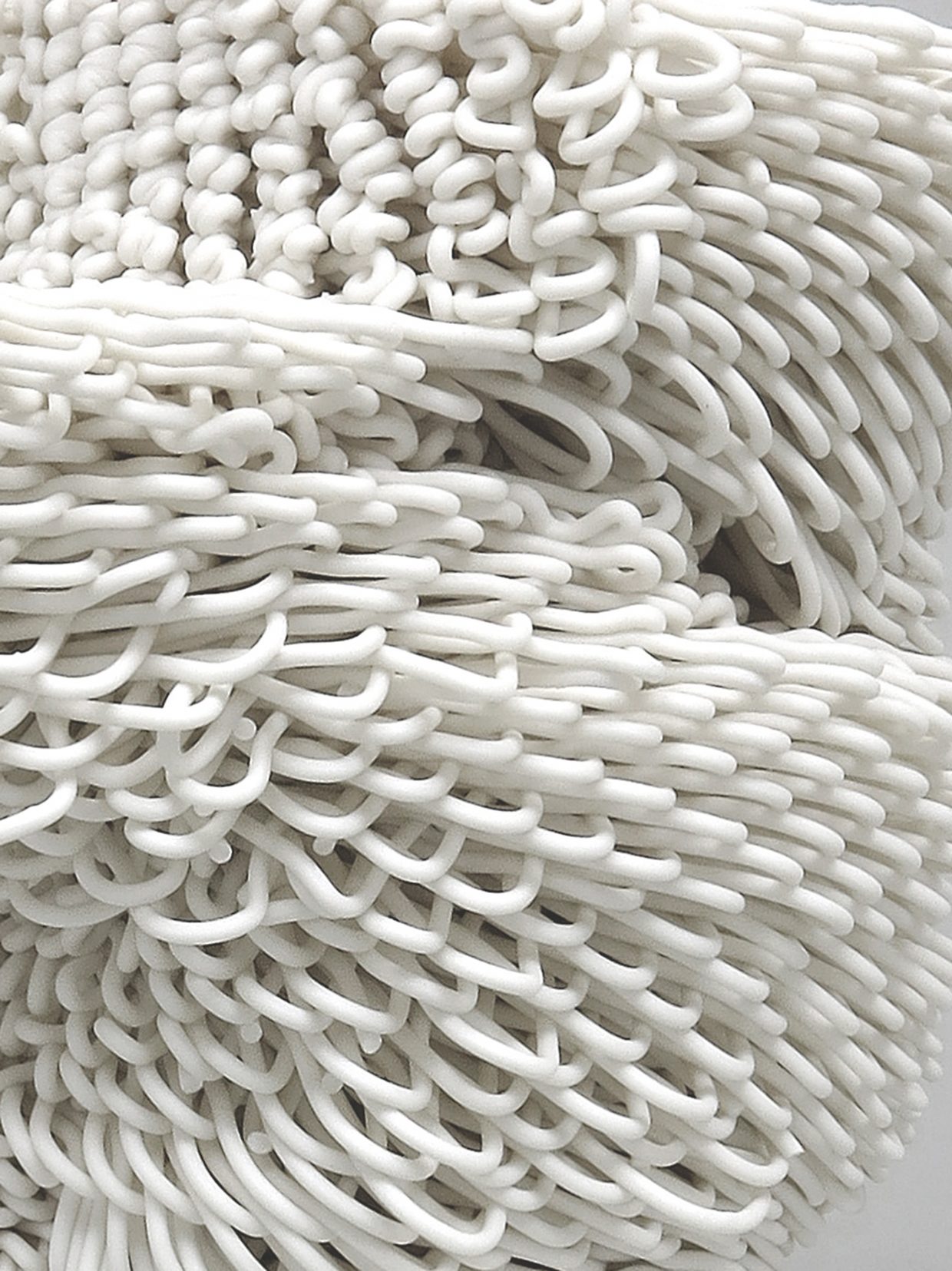
Powder printing experiments
The FH-Potsdam is equipped with a powder printer Z350. The powder is distributed very thinly and evenly in a pressure chamber, then it is wetted with a print head similar to that of ink jet printers at the places where it is to harden later. The objects are solid after printing, but very unstable and porous. Only after infiltration, e.g. with plastic, do they obtain their final properties.
The Z350 printer is currently operated with a powder/binder combination, which is sold by the manufacturer at relatively high prices (powder 75€/kg, binder 210€/litre). From publications of the “Solheim Additive Manufacturing Laboratory in the Mechanical Engineering Department on the University of Washington Campus” alternative combinations of powder and binder are known today. This would reduce costs to a small fraction because they are based on materials such as gypsum, maltodextrin and alcohol, which are very cheap to obtain. Model construction and prototyping could not only be used at the end of the design projects, but iteratively in the course of them. In addition, “material recipes” have been published that produce a wide range of properties. In principle, for example, any solid material can be printed in powder form when mixed with maltodextrin, a type of sugar. A mixture of water and alcohol can be used as a binder, which cross-links the sugar molecules and thus binds in other particles. For example, by using rice flour-maltodextrin powder and infiltrating it with wax, it is possible to produce a melt-out mould which can then be cast in a sand mould with liquid glass or metal in a further processing step. The aim of application research in powder printing could initially be to repeat the experiments from Washington and make suitable recipes manageable. This would not only increase the possibilities of material variations, but would also make research and teaching more economical in general.
Ceramics
Let us get back to Additive Addicted and porcelain: Ceramics can also be used as a powder material in the process described above. Instead of infiltrating with plastic, ceramic can be sintered in a ceramic furnace in a second step. The use of gypsum as a powder material also promises the production of negative molds for use as ceramic casting molds. This would allow ceramics to be produced and reproduced on the basis of 3D models. Another field of application for ceramics is the use of liquid ceramic casting mass and open-pored foam. This is soaked with it, then dried and fired in the kiln. The foam component is debonded and a porous, stable and at the same time light ceramic foam structure remains. The process is now used to manufacture ceramic filters for filtering liquids such as gases. If the sponge were placed in a 3D printed exoskeleton, it could be brought into any conceivable volume shape. Foam ceramics, such as the technically related metal foam materials, offer a special property due to their very low density, a considerable weight saving with an approximate retention of the mechanical properties of the starting material. They are therefore also suitable for lightweight constructions.
